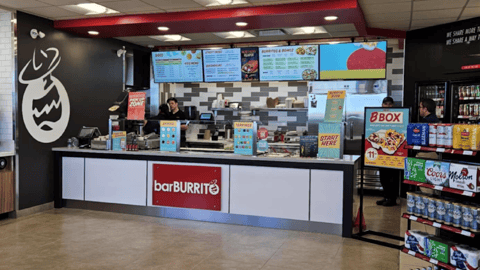Fast food 'value war' to last into 2025 as consumer appetite for deals heats up
It's lunch time at the Eaton Centre mall in downtown Toronto and every corner of the food court is hungry for customers.
Bourbon St. Grill is trying to lure them in with a pair of beef or chicken Jamaican patties for $5 and a "budget-friendly" meal for students priced at $10.99.
Nearby, New York Fries is hoping a $7.49 hotdog and pop combo designed for "lunchfast, lupper or snacktime" will do the trick, and over at Sansotei Ramen, it's all about an offer knocking $2 off tonkotsu or spicy tan tan.
This onslaught of promotions has taken shape at just about every fast-food joint across the country, and the phenomenon has intensified into what industry watchers have dubbed a “value war."
They're predicting the battle for your buck isn't going away anytime soon and may even hit new heights next year.
"It's going to be at least the first six months of 2025, when we're going to be seeing elevated promotions, but it's likely going to be the entire 2025," said Danilo Gargiulo, investment research firm Bernstein's senior analyst specializing in restaurants.
The value war didn't materialize overnight. Consumer habits shifted in the years coming out of COVID-19 lockdowns, when government supports and a lack of opportunities to go out boosted savings. When health measures were lifted, people spent the cash they were sitting on, but as prices, interest rates and inflation spiked, consumers pulled back.
For fast food chains, that meant diners ditched sides, opted for snacks instead of larger meals or even avoided quick-serve restaurants altogether. The decrease in customers has persisted even as inflation eased, leaving the quick-serve industry with a big question: how do we get customers back into restaurants and spending again?
The answer so far has been promotions.
McDonald's Canada added several items to its McValue menu priced at $4 or less and dropped the cost of a small coffee to $1.
Not wanting to be outdone by the Golden Arches, Wendy's advertised a two-for-$4 breakfast menu and offered a Pineapple Under the Sea Frosty and Krabby Patty burger à la SpongeBob SquarePants.
Even Tim Hortons couldn't resist joining in. In recent months, it has discounted breakfast sandwiches to $3 for customers buying a coffee and also offered promotions allowing coffee purchasers to get a $1 doughnut.
"All these collaborations and limited time offers really try to put consumers back into the store with the idea that once you're there, you can really discover how nice it is, how good the experience is and maybe you're going to come back," Gargiulo said. "If consumers are not in the store, you cannot upsell them, you cannot cross-sell them, you cannot entice them to be going extra-large with their menu or maybe try new items that are priced a little bit higher."
Recognizing customers needed an incentive to visit, Taco Bell Canada tested a Cravings Value menu in November 2022, making it permanent in May 2023.
The double-stacked tacos and beefy five-layer burritos that made up the menu were all priced at $3.50 or less "because customers are expecting more for their money," said Meera Patel, the head of marketing at the company's Canadian arm.
More than a year later, that expectation hasn't subsided, so Taco Bell expanded the menu, adding a caramel apple empanada from the '80s and a Meximelt from the '90s in late November.
While competition always abounds, Patel foresees a new spate in the new year.
"I've been tracking competitors’ offerings for the last four years and I see trends now ... January and February, you go really heavy with strategic value," Patel said, predicting offers priced at two for $5, $6 or $7 will be popular. In February, you probably introduce something new because wallets are more beefed up at that point."
Many brands won't resist one-upping their rivals.
"If one brand goes and drops their nuggets to $3 for 10, another brand is going to be doing the same thing," she said
Sitting it out of the fast-food wars can be dangerous — a lesson Popeyes Louisiana Kitchen learned when its system-wide sales fell 0.8% and its comparable sales almost 4% last quarter.
Joshua Kobza, CEO of Popeyes parent company Restaurant Brands International (RBI), blamed the performance on “a more value-sensitive environment this quarter” and the chain “missing some of the offers consumers were looking for."
On RBI’s earnings call in November, he said Popeyes began working to reverse the trend with three pieces of chicken for $5 in mid-September. That was followed in October with a $6 big box. Both boosted traffic and sales.
Eric Lefebvre, the CEO of MTY Group, a Quebec-based owner of dozens of restaurant brands including Thai Express, Mr. Sub and Timothy's, notices promotions come in waves and crop up in some niches but not others.
Pizzerias are "super aggressive on value" in part because there are many places to grab a pie, he said.
Chains offering ethnic food, however, are "a little bit less driven by value (because) they're probably a little bit harder to substitute or to replicate at home." Shops specializing in snacks like ice cream and pretzels likewise miss out on some competition because they sell "impulse buys" customers often only think to purchase after seeing or smelling them.
When promotions surface, choosing which to counter and how is "an art more than science," Lefebvre said.
The decision reflects food costs, shifts in minimum wage, the state of the labour market, franchisee expectations and even advertising budgets.
McDonald's, for example, is known to have the deepest marketing coffers.
"Sometimes they do stuff and we're like, 'Well, we can't play that game or we don't want to play that game, we'll wait it out. It's going to end at some point,'" Lefebvre said. "But sometimes you have to jump in and try to come up with a competitive offer."
When McDonald's makes a move like $1 coffee, he said some brands "can't necessarily play on price," so they experiment with selling $1 coffee but only in a combo with other items.
The goal of any deal is to build the perception of value but ensure customers aren't conditioned into only visiting for a promotion.
"Remember the $5 footlong at Subway?" Lefebvre said. "It was very successful while it lasted, but it took them a long time to shake it off after, so you don't want to create that expectation that your product is supposed to be at X price and then you just can't make money off of it."
Despite the pitfalls of promotions, Lefebvre predicts the current wave is "probably going to last for a very long time," so the industry and customers alike "need to look at today's environment as probably more normal than what we were going through last year."
Gargiulo, however, foresees some nuance arriving next year.
"You're going to see more concepts — instead of putting a patch onto the leakage of traffic — actually thinking more holistically and more organically about what value means for their consumers."





